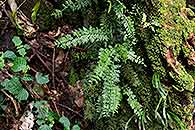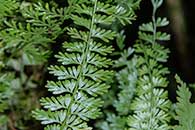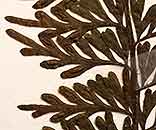Asplenium dregeanum Kunze
Synonyms |
Asplenium brachypteron Kunze |
|---|---|
Common name |
|
Description |
Rhizome erect, to 5 mm thick; rhizome scales brown, lanceolate to narrowly ovate in outline, 1-5 mm long, margins entire, pale. Fronds tufted, herbaceous, erect to arching, proliferous below the apex, the apical segment above the proliferating bud has less than 5 lobes. Stipe up to 17 cm, usually less than half the length of the lamina, greyish-brown, sometimes narrowly winged, subglabrous. Lamina 10-39 cm × 2.5-6 cm, 2-pinnate to 3-pinnatifid, narrowly lanceolate to narrowly oblong(-elliptic) in outline, lowest pinnae hardly reduced, apical segment deeply pinnatifid with 3-5 lobes. Pinnae 13-32 pairs, petiolate, rhombic-oblong or narrowly oblong in outline, up to 35 × 11 mm, acroscopically developed, glabrous to subglabrous, lobes narrowly oblong-obtuse. Pinnae with 1-3 basiscopic pinnae lobes; the first arising between the 2nd-4th acroscopic lobes. Rhachis matt-greyish-green when dry, with occasional pale brown minute scales. Sori 2-3 mm long, elliptic, one centrally located per lobe, indusium elliptic, entire, membranous, to 1 mm wide. |
Notes | Confused with similar species; A. dregeanum has finer divided fronds with the the first basal lobe arising between the 2nd and 4th acroscopic lobes. |
Derivation | dregeanum: named after J.F. Drège (1794-1881), a German horticulturist and plant collector in southern Africa. |
Habitat | In areas with deep shade and abundant moisture in evergreen forests, mossy rocks, often by streamsides. |
Distribution worldwide | Africa, Madagascar, Comoro Isl. |
Distribution in Africa |
Angola, Burundi, Cameroon, Dem. Republic of Congo, Equatorial Guinea (incl. Bioko), Ethiopia, Gabon, Ghana, Guinea, Ivory Coast, Kenya, Liberia, Malawi, Mozambique, Nigeria, Rwanda, Sierra Leone, South Africa, Sudan and South Sudan, Tanzania , Togo, Uganda, Zambia, Zimbabwe. |
Growth form |
Epiphytic, lithophytic, terrestrial. |
Literature |
|




